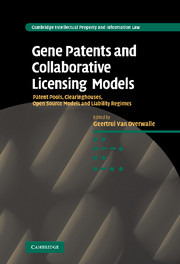 Gene Patents and Collaborative Licensing Models
Gene Patents and Collaborative Licensing Models Book contents
- Frontmatter
- Contents
- List of contributors
- Preface
- Foreword: Jean-Jacques Cassiman
- List of abbreviations
- Part I Patent pools
- Part II Clearinghouses
- 5 Clearinghouse mechanisms in genetic diagnostics. Conceptual framework
- 6 Case 3. The Global Biodiversity Information Facility (GBIF). An example of an information clearinghouse
- 7 Case 4. BirchBob. An example of a technology exchange clearing house
- 8 Case 5. The Public Intellectual Property Resource for Agriculture (PIPRA). A standard license public sector clearinghouse for agricultural IP
- 9 Case 6. The Science Commons Material Transfer Agreement Project. A standard licence clearinghouse?
- 10 Case 7. The collective management of copyright and neighbouring rights. An example of a royalty collection clearinghouse
- 11 Comment on the conceptual framework for a clearinghouse mechanism
- Part III Open source models
- Part IV Liability regimes
- Part V Different perspectives
- Part VI Summary and concluding analysis
- Index
- Titles in the series
8 - Case 5. The Public Intellectual Property Resource for Agriculture (PIPRA). A standard license public sector clearinghouse for agricultural IP
from Part II - Clearinghouses
Published online by Cambridge University Press: 14 January 2010
- Frontmatter
- Contents
- List of contributors
- Preface
- Foreword: Jean-Jacques Cassiman
- List of abbreviations
- Part I Patent pools
- Part II Clearinghouses
- 5 Clearinghouse mechanisms in genetic diagnostics. Conceptual framework
- 6 Case 3. The Global Biodiversity Information Facility (GBIF). An example of an information clearinghouse
- 7 Case 4. BirchBob. An example of a technology exchange clearing house
- 8 Case 5. The Public Intellectual Property Resource for Agriculture (PIPRA). A standard license public sector clearinghouse for agricultural IP
- 9 Case 6. The Science Commons Material Transfer Agreement Project. A standard licence clearinghouse?
- 10 Case 7. The collective management of copyright and neighbouring rights. An example of a royalty collection clearinghouse
- 11 Comment on the conceptual framework for a clearinghouse mechanism
- Part III Open source models
- Part IV Liability regimes
- Part V Different perspectives
- Part VI Summary and concluding analysis
- Index
- Titles in the series
Summary
Introduction
Agricultural research has historically been publicly funded and delivered as a public good directly to farmers through seeds which incorporate advanced genetics or through the demonstration of improved agricultural practices. However, over the last twenty years, the results of agricultural research have increasingly been treated as private goods and protected through various forms of IP belonging to the primary innovator. IP protection has provided incentives to develop new crops that may otherwise not have been developed and, in particular, to invest in the increasingly expensive regulatory processes for approvals of genetically engineered crops. In contrast to many technology sectors, public and non-profit institutions have played a very large role in new technological innovations in agriculture, accounting for nearly one quarter of new patented innovations in this sector. However, this technology “portfolio” is fragmented across a large number of institutions and has not been strategically managed to enable the advancement of a number of projects. The Public Intellectual Property Resource for Agriculture (PIPRA) is a clearinghouse institution that is designed to integrate this fragmented IP portfolio through collaborative management. PIPRA's goal is to mobilize technologies from a wide range of public/non-profit technology providers to address specific projects for the improvement of subsistence and specialty crops that are not being addressed by commercial seed and agricultural biotechnology companies. PIPRA and its members believe this landscape of IP can be more effectively managed collaboratively and by using a set of shared principles.
- Type
- Chapter
- Information
- Gene Patents and Collaborative Licensing ModelsPatent Pools, Clearinghouses, Open Source Models and Liability Regimes, pp. 135 - 142Publisher: Cambridge University PressPrint publication year: 2009
- 2
- Cited by


